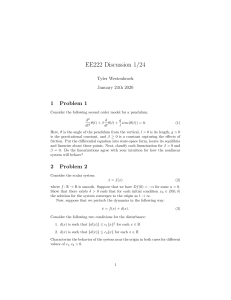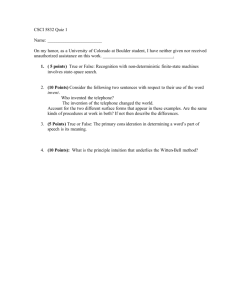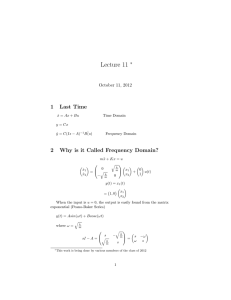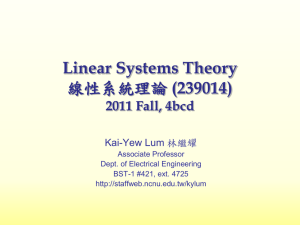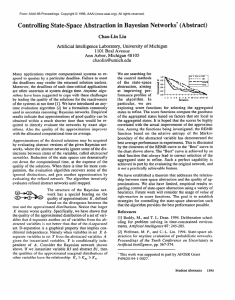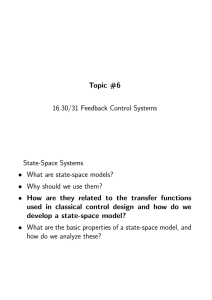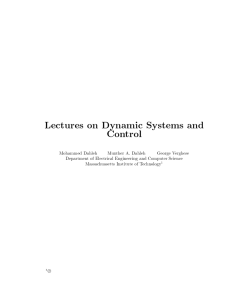Lecture 20 1 Pontryagin Maximum Principal (First Version) ∗
advertisement
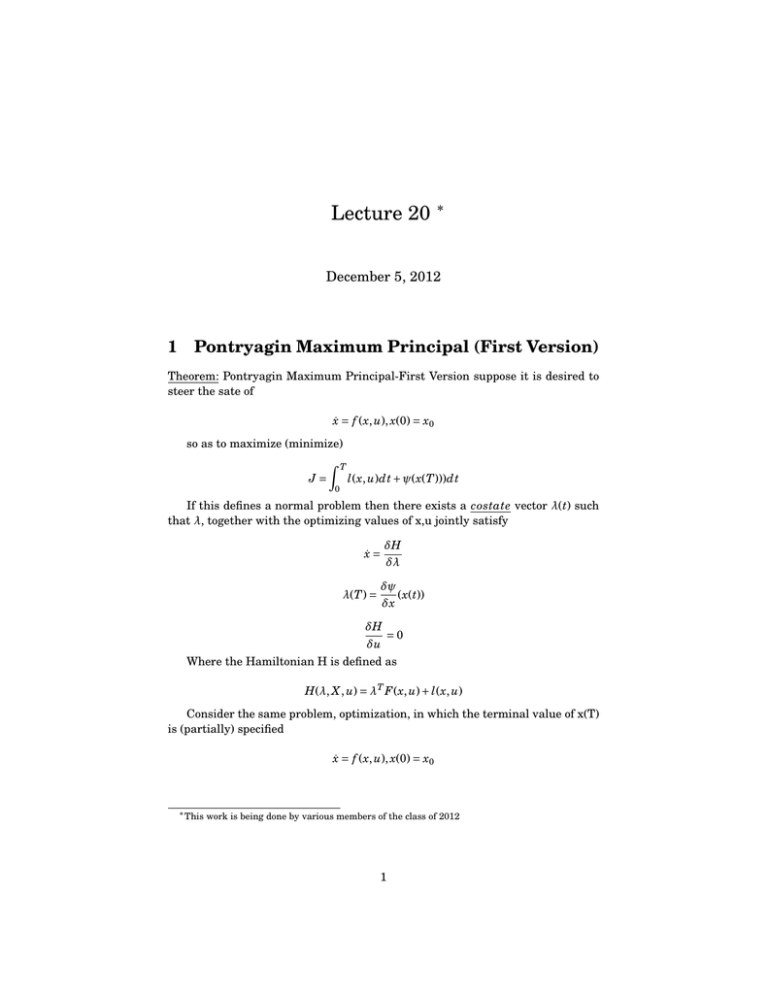
Lecture 20 ∗ December 5, 2012 1 Pontryagin Maximum Principal (First Version) Theorem: Pontryagin Maximum Principal-First Version suppose it is desired to steer the sate of ẋ = f ( x, u), x(0) = x0 so as to maximize (minimize) T Z J= 0 l ( x, u) dt + ψ( x(T ))) dt If this defines a normal problem then there exists a costate vector λ( t) such that λ, together with the optimizing values of x,u jointly satisfy δH ẋ = λ(T ) = δλ δψ δx δH δu ( x( t)) =0 Where the Hamiltonian H is defined as H (λ, X , u) = λT F ( x, u) + l ( x, u) Consider the same problem, optimization, in which the terminal value of x(T) is (partially) specified ẋ = f ( x, u), x(0) = x0 ∗ This work is being done by various members of the class of 2012 1 Dynamic Systems: State-space control 2 and we wish to optimize J = ψ( x( t)) + T Z l ( x( t), u( t)) dt 0 X 1 (T ), ...., X r (T ) with specific terminal values ( r ≤ n) The approach for the solution again involves infinite dimensional Lagrange Multipliers Ĵ = ψ( x, t) + T Z 0 H (λ( t), x( t), u( t)) − λ( t)T ẋ( t) dt with H (λ, x, u) = λT f ( x, u) + l ( x, u). suppose x1 ( T ) . . x( T ) = . xr (T ) xn (T ) with X 1 (T ), ...., X r (T ) specified. In order to first orderize J δ J̄ = δψ δx Z ( x∗ (T )−λ(T ))T δ x( t)+ T 0 δH δx Z (λ, x∗ , u∗ )+λ̇( t))T δ x( t) dt+ T 0 δH δx (λ, x∗ , u∗ )δ u( t) dt As in the last lecture we choose λ( t) to satisfy λ(˙t) = −δδxH making the 2nd term in the above equation vanish since δ x j (T ) = 0 f ori = 1, ....., r The corresponding costate component λ j (T ) are not constrained so now the P.M.P. becomes ẋ = f ( x, u), x(0) = x0 λ̇ = −δ f T δl λ( t) − δx δx λr+1 (T ) = δψ δx ( x(T ))r+1 ......... λn (T ) = δψ δx ( x(T ))n Dynamic Systems: State-space control 3 δH = 0, δU X 1 ( T ) = x1 X 2 (T ) = X 2 ↓ X r (T ) = X r Example Finite Dimensional LTI system We would like to steer ẋ = Ax + Bu from x(0) = x0 to x(T ) = x1 so as to minimize J= 1 2 T Z 0 || u( t)||2 dt To solve, first let us write down the Hamiltonia 1 H (λ, x, u) = λT Ax + λT Bu + || u||2 2 the P.M.P. necessary conditions say that there is a costate λ( t), which together with the optimizing values of "x" and "u" satisfy λ̇ = − A T λ( t) B T λ( t) + u( t) = 0 λ̇ = Ax + Bu T From the first equation λ( t) = e− A t λ0 for some λ0 ∈ Rn u( t) = −B T λ( t) T = −B T e− A λ0 Now λ0 must be chosen s.t. the boundary conditions x(0) = x0 , x( t) = x, are met, so from the variation of constants formula x( t) = e at x0 − T Z 0 e A ( t−s) BB T e− A Ts dsλ0 Dynamic Systems: State-space control 4 having the boundary conditions met requires that x( t) = e at ( x0 − T Z e− A (s) BB T e− A Ts 0 dsλ0 In other words T Z e− A (s) BB T e− A Ts 0 dsλ0 = ( x0 − e− AT x1 ) Hence, λ0 = W −1 ( x0 − eAT x1 ) where T Z e− A (s) BB T e− A Ts ds 0 Note: That W is an invertible n x n matrix if the system is controllable. Summary: The control law that steers ẋ = Ax + Bu f romx(0) = x0 toX (T ) = x1 so as to minimize the norm of control squared is integrated T Z 0 || u( t)||2 dt Is given by u ( t ) = − B T e (− A where λ0 is the soltuion to x0 − e T Z −AT T t) λ0 x1 = W λ0 with e− A (s) BB T e− A Ts ds 0 Other linear quadratic Optimization problems: Free Endpoint Problem (not specifying the final endpoint) ẋ = Ax + Bu steer this system so as to minimize J= 1 2 T Z 0 xT ( t)Qx( t) + u T ( t)Ru( t) dt Where R is symmetric and positive definite, and Q is symmetric and positive semi-definite. Dynamic Systems: State-space control 5 For this problem the Hamiltonian is λT Ax + λT Bu + 12 u T Ru the P.M.P necessary conditions are x = A T λ − Qx; λ(T ) = 0 ẋ = − A T λ − Qx Ru + B T λ = 0 R is invertable because it is positive definite u( t) = −R −1 B T λ( t) ẋ = Ax − BR −1 B T λ λ̇ = − A T λ − Qx x(0) = x0 , λ(T ) = 0 ← f romP.M.P suppose we can write λ(T ) = M ( t) x( t) λ̇ = M Ṁx + M ẋ from x equation = Ṁx + M A − MBR −1 B T Mx from the λ equation = − A T Mx − Qx This will be satisfied for any X(t) of M(t) satisfies the matrix Riccoti equation Ṁ + A T M + M A − MBR −1 B T M + Q = 0(R ) To meet the boundary conditions λ(T ) = 0 we require that M(t)=0 Dynamic Systems: State-space control 6 The question of Existance of M Consider the Scalar Riccoti equation Ṁ = −2 M + M 2 + 1 M (T ) = 0 (This would be associated with Optimization) ẋ = x + u T Z J= 0 note: ṁ = ( m − 1)2 and get u2 ( t) − x2 ( t) dt k̇ = k2 This is a solution of the form k ( t) = k̇( t) = α 1 − αt α2 (1 − α t)2 = k ( t )2 One can prove that the solution is unique. Choose α s.t. M(t) = 0 i.e. K(T) = -1 then α 1 − αt = −1 → α = 1 T −1 For example when T=2 and α = 1 and k( t) = M ( t) = 1 1−T 1 1− t Which blows up at t = 1 So the quadratic is not always the best option since it has a finite blow up times We state the following without proof Theorem: If A,B is a controllable pair, Q = Q T is positive semi-definite, then the solution to the Riccoti equation (T) passing through 0 at t=T exists and is positive semi-definite on an interval [ t 0 , T ] for any t 0 ≺ T Dynamic Systems: State-space control Previw of the next time Theorem: Suppose A,B is a controllabe pair. The conrol law that steers ẋ = Ax + Bu so as to minimize Z 0 T xT Qx + u T Rudt is given by u( t) = −R −1 B T M ( t) x( t) where M satisfies Ṁ + M A + A T M − MBR −1 B T M + Q = 0 M (T ) = 0 7
